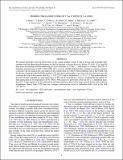Files in this item
Probing the gaseous disk of T Tau N with CN 5-4 lines
Item metadata
| dc.contributor.author | Podio, L. | |
| dc.contributor.author | Kamp, I. | |
| dc.contributor.author | Codella, C. | |
| dc.contributor.author | Nisini, B. | |
| dc.contributor.author | Aresu, G. | |
| dc.contributor.author | Brittain, S. | |
| dc.contributor.author | Cabrit, S. | |
| dc.contributor.author | Dougados, C. | |
| dc.contributor.author | Grady, C. | |
| dc.contributor.author | Meijerink, R. | |
| dc.contributor.author | Sandell, G. | |
| dc.contributor.author | Spaans, M. | |
| dc.contributor.author | Thi, W.-F. | |
| dc.contributor.author | White, G.J. | |
| dc.contributor.author | Woitke, P. | |
| dc.date.accessioned | 2014-09-02T10:01:02Z | |
| dc.date.available | 2014-09-02T10:01:02Z | |
| dc.date.issued | 2014-03-10 | |
| dc.identifier | 145268872 | |
| dc.identifier | 8b41643a-5396-4a20-8c4c-574e61b5425f | |
| dc.identifier | 84895161016 | |
| dc.identifier | 000332516300002 | |
| dc.identifier.citation | Podio , L , Kamp , I , Codella , C , Nisini , B , Aresu , G , Brittain , S , Cabrit , S , Dougados , C , Grady , C , Meijerink , R , Sandell , G , Spaans , M , Thi , W-F , White , G J & Woitke , P 2014 , ' Probing the gaseous disk of T Tau N with CN 5-4 lines ' , Astrophysical Journal Letters , vol. 783 , no. 2 , L26 . https://doi.org/10.1088/2041-8205/783/2/L26 | en |
| dc.identifier.issn | 2041-8205 | |
| dc.identifier.uri | https://hdl.handle.net/10023/5321 | |
| dc.description | L.P. and S.D.B. acknowledge funding from the European FP7 (PIEF-GA-2009-253896) and the National Science Foundation (AST-0954811). | en |
| dc.description.abstract | We present spectrally resolved observations of the young multiple system T Tau in atomic and molecular lines obtained with the Heterodyne Instrument for the Far Infrared on board Herschel. While CO, H2O, [C II], and SO lines trace the envelope and the outflowing gas up to velocities of 33 km s-1 with respect to systemic, the CN 5-4 hyperfine structure lines at 566.7, 566.9 GHz show a narrow double-peaked profile centered at systemic velocity, consistent with an origin in the outer region of the compact disk of T Tau N. Disk modeling of the T Tau N disk with the thermo-chemical code ProDiMo produces CN line fluxes and profiles consistent with the observed ones and constrain the size of the gaseous disk (Rout 110+10-20 AU) and its inclination (i = 25°± 5°). The model indicates that the CN lines originate in a disk upper layer at 40-110 AU from the star, which is irradiated by the stellar UV field and heated up to temperatures of 50-700 K. With respect to previously observed CN 2-1 millimeter lines, the CN 5-4 lines appear to be less affected by envelope emission, due to their larger critical density and excitation temperature. Hence, high-J CN lines are a unique confusion-free tracer of embedded disks, such as the disk of T Tau N. | |
| dc.format.extent | 6 | |
| dc.format.extent | 412658 | |
| dc.language.iso | eng | |
| dc.relation.ispartof | Astrophysical Journal Letters | en |
| dc.subject | Astrochemistry | en |
| dc.subject | ISM: molecules | en |
| dc.subject | Protoplanetary disks | en |
| dc.subject | Stars: individual (T Tau) | en |
| dc.subject | QB Astronomy | en |
| dc.subject | QC Physics | en |
| dc.subject.lcc | QB | en |
| dc.subject.lcc | QC | en |
| dc.title | Probing the gaseous disk of T Tau N with CN 5-4 lines | en |
| dc.type | Journal article | en |
| dc.contributor.institution | University of St Andrews. School of Physics and Astronomy | en |
| dc.identifier.doi | 10.1088/2041-8205/783/2/L26 | |
| dc.description.status | Peer reviewed | en |
This item appears in the following Collection(s)
Items in the St Andrews Research Repository are protected by copyright, with all rights reserved, unless otherwise indicated.

